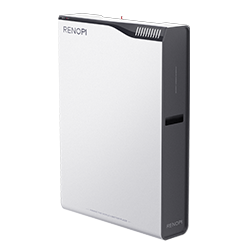In today’s rapidly evolving energy storage market, the wall‑mounted lithium battery offered by RENOPI (Shenzhen) New Energy Technology Co., Ltd. introduces a transformative design concept when compared to traditional storage systems such as ground‑mounted or cabinet‑style installations. Here's a detailed look at how the structural form‑factor and characteristics set it apart:

Compact, Space‑Saving Installation
Unlike large cabinet systems or floor‑mounted racks that require considerable footprint, the RENOPI wall‑mounted lithium battery is designed for vertical installation on a wall. This means it occupies significantly less horizontal space and can be integrated into existing rooms, utility closets, or garage walls. For homeowners or commercial users seeking maximum usable floor space, this is a major advantage.
Simplified Structural Integration
Traditional storage systems often require reinforced slab foundations, raised platforms, heavy support structures, or dedicated floor space with clearance around cabinets. In contrast, the wall‑mounted design simplifies installation: with proper wall anchoring and minimal clearance needed, the system can be installed more swiftly and with fewer structural modifications. This lowers installation complexity, cost, and time.
Flexible Placement & Aesthetic Harmony
With cabinet or ground systems, placement is somewhat constrained — the system often becomes a prominent feature in a utility room or mechanical space. A wall‑mounted system offers flexibility: it can be recessed, placed in a closet, or positioned in a less obtrusive location. Additionally, because it is mounted like a piece of equipment on a wall, it can be better integrated with interior space aesthetics, making it more suitable for residential or design‑conscious installations.
Improved Cooling and Maintenance Access
When installed on a wall, airflow around the battery system can be better managed than a cabinet densely packed in a corner. The vertical mounting offers better access for service or monitoring. The design also enables the bottom or side of the battery to remain accessible for connections and inspection, whereas large cabinets may restrict maintenance access or require significant clearance.
Modular Upgradeability & Scalability
Given its compact format, wall‑mounted systems like those from RENOPI often support modular expansion—adding additional units side‑by‑side or vertically, rather than replacing a large cabinet. Users who start with a smaller capacity (for example 5.12 kWh) can later upgrade by installing a second wall unit rather than re‑configuring an entire rack system. This incremental approach gives better flexibility for evolving energy demands.
Cost‑Effective Infrastructure and Installation
Installing a large floor‑mounted cabinet can involve higher labor, structural reinforcement, and dedicated space allocation (ventilation, access doors, partitions). The wall‑mounted solution reduces many of these burdens: fewer materials, simpler mounting, less space reserved. These savings translate into lower upfront capital cost and faster deployment.
Better Suitability for Retrofitting Existing Buildings
When retrofitting older homes, commercial spaces, or multi‑unit buildings, floor space may be limited or already allocated. The wall‑mounted format enables installation in locations that would otherwise be unusable for floor‑mounted systems (e.g., corridor walls, shared equipment rooms). This advantage makes it an attractive choice for upgrading existing infrastructure.
In summary, the wall‑mounted lithium battery from RENOPI offers a structural and functional leap over traditional storage systems by providing a compact footprint, flexible installation, and streamlined integration—making advanced energy storage accessible, cost‑efficient, and aesthetically compatible with modern spaces.




 SUBSCRIBE
SUBSCRIBE